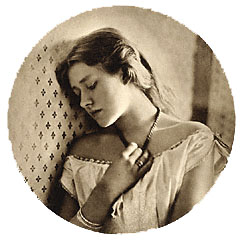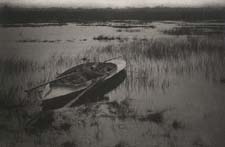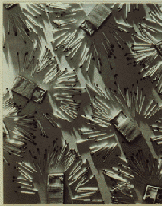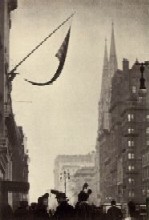|




|
The fight to certify photography as a fine art has been among the
medium's dominant philosophical preoccupations since its inception.
Photography's legitimacy as an art form was challenged by artists
and critics, who seized upon the mechanical and chemical aspects
of the photographic process as proof that photography was, at best,
a craft. Perhaps because so many painters came to rely so heavily
on the photograph as a source of imagery, they insisted that photography
could only be a handmaiden to the arts.
To prove that photography was indeed an art, photographers at first
imitated the painting of the time. Enormous popularity was achieved
by such photographers as O. J. Rejlander and Henry Peach Robinson,
who created sentimental genre scenes by printing from multiple negatives.
Julia Margaret Cameron blurred her images to achieve a painterly
softness of line, creating a series of remarkably powerful soft-focus
portraits of her celebrated friends.
In opposition to the painterly aesthetic in photography was P.
H. Emerson and other early advocates of what has since become known
as “straight” photography. According to this approach
the photographic image should not be tampered with or subjected
to handwork or other affectations lest it lose its integrity. Emerson
proposed this philosophy in his controversial and influential book,
Naturalistic Photography (1889). Appropriately, Emerson was the
first to recognize the importance of the work of Alfred Stieglitz,
who battled for photography's place among the arts during the first
part of the 20th cent.
In revolt against the entrenched imitation of genre painting known
as “salon” photography, Stieglitz founded a movement which
he called the Photo-Secession, related to the radical secession
movements in painting. He initiated publication of a magazine, Camera
Work (1903–17), which was a forum for the Photo-Secession and
for enlightened opinion and critical thought in all the arts. It
remains the most sumptuously and meticulously produced photographic
quarterly in the history of the medium. In New York City, Stieglitz
opened three galleries, the first (1908–17) called “291”
(from its address at 291 Fifth Ave.), then the Intimate Gallery
(1925–30), and An American Place (1930–46), where photographic
work was hung beside contemporary, often controversial, work in
other media.
Stieglitz's own photographs and those of several other Photo-Secessionists,
Edward Steichen, one of his early protégés; Frederick
Evans, the British architectural photographer; and the portraitist
Alvin L. Coburn, adhered with relative strictness to a “straight”
aesthetic. The quality of their works, despite a pervasive self-consciousness,
was consistently of the highest craftsmanship. Stieglitz's overriding
concern with the concept “art for art's sake” kept him,
and the audience he built for the medium, from an appreciation of
an equally important branch of photography: the documentary.
The power of the photograph as record was demonstrated in the 19th
cent., as when William H. Jackson's photographs of the Yellowstone
area persuaded the U.S. Congress to set that territory aside as
a national park. In the early 20th cent. photographers and journalists
were beginning to use the medium to inform the public on crucial
issues in order to generate social change.
Taking as their precedents the work of such men as Jackson and
reporter Jacob Riis (whose photographs of New York City slums resulted
in much-needed legislation), documentarians like Lewis Hine and
James Van DerZee began to build a photographic tradition whose central
concerns had little to do with the concept of art. The photojournalist
sought to build, strengthen, or change public opinion by means of
novel, often shocking images. The finished form of the documentary
image was the inexpensive multiple, the magazine or newspaper reproduction.
For a time the two traditions, art photography and documentary photography,
appeared to be merged within the work of one man, Paul Strand. Strand's
works combined a documentary concern with a lean, modernist vision
related to the avant-garde art of Europe.
|

